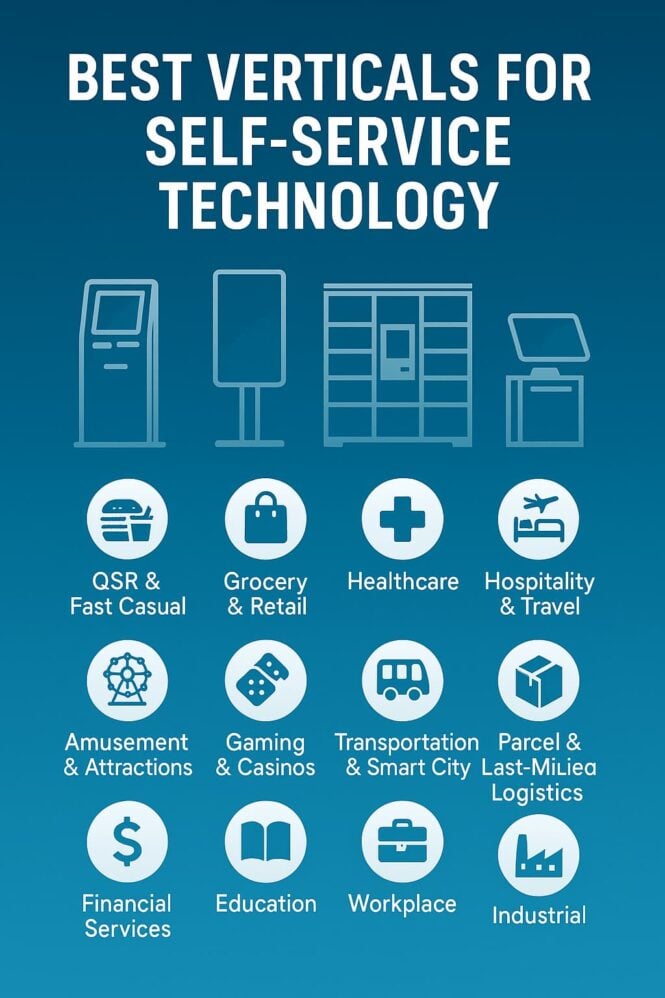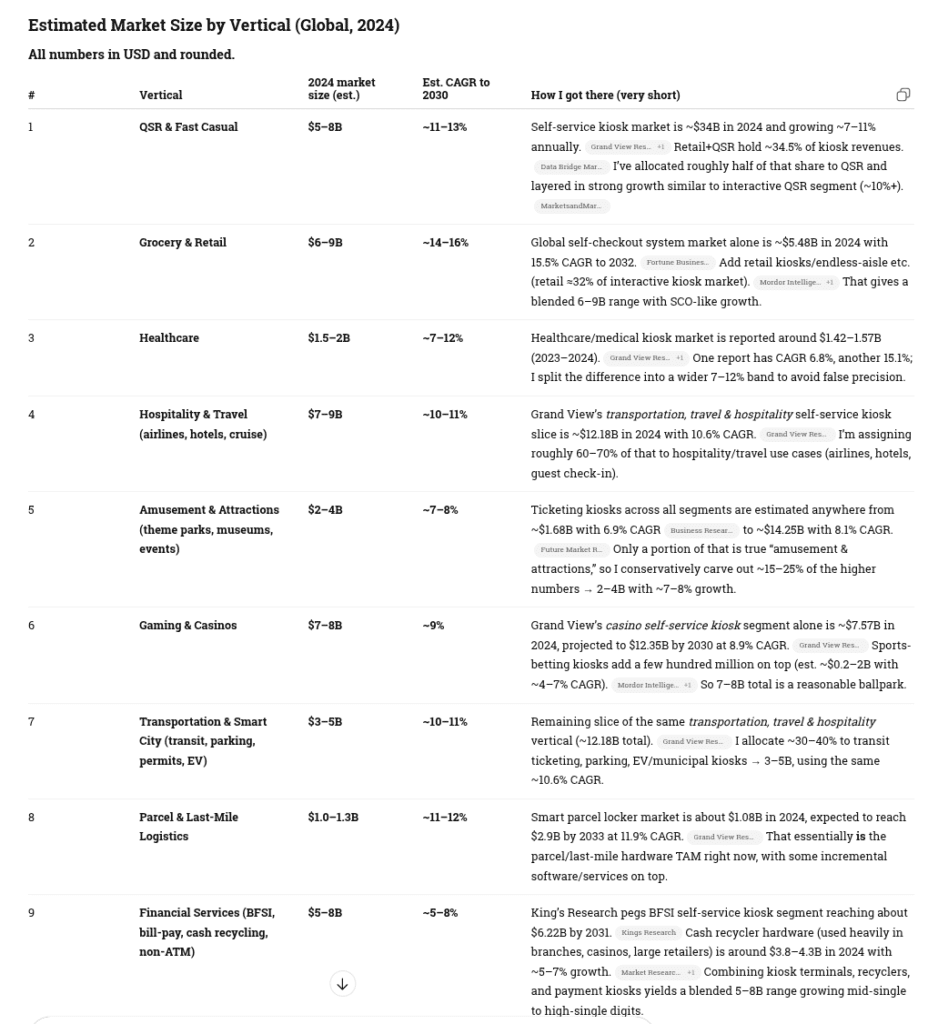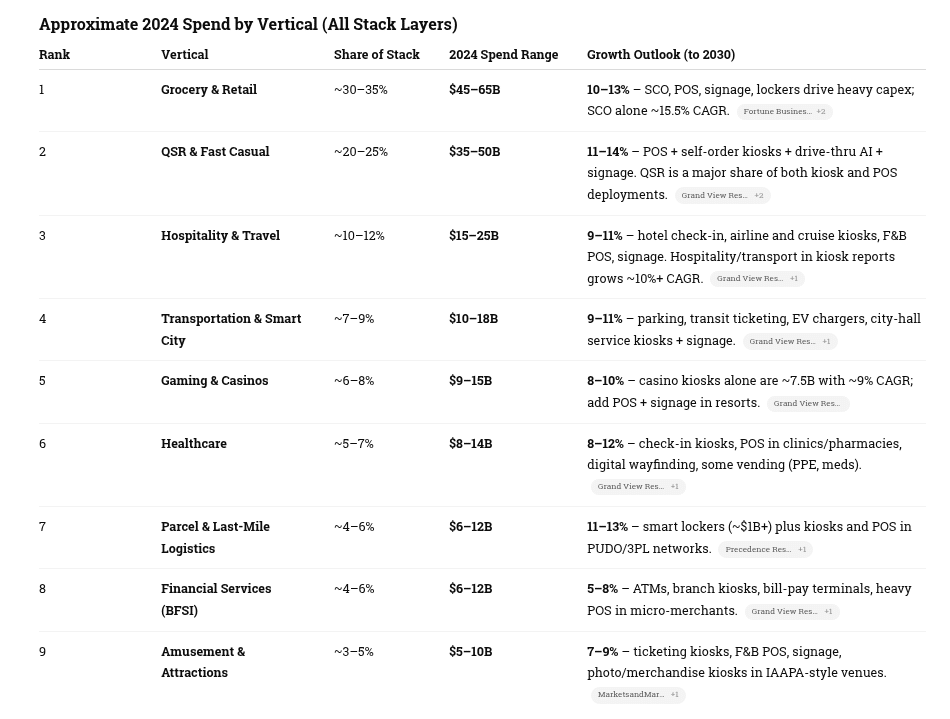
Where Kiosks, Digital Signage & Unattended Retail Deliver ROI
We are constantly asked. “Where does self-service technology these days benefit the retailer and the customer.
Self-service technology has moved far beyond simple ticketing or check-in. In 2025–2026, the strongest growth is coming from multi-modal automation ecosystems — kiosks, digital signage, vending, AI-driven POS, smart lockers, and cloud analytics. Across The Industry Group network, we consistently see a blend of labor efficiency, higher throughput, and better customer experience driving adoption.
Below is a breakdown of the top-performing verticals, why they’re surging, and where OEMs, integrators, and operators should focus for the highest return.
Top Verticals Overview (2025–2026)
1. QSR & Fast Casual Restaurants
Demand for kiosks, menu boards, AI-ordering, and pickup lockers continues to outpace all other sectors. Upsell automation alone drives some of the fastest ROI.
2. Grocery & Retail
Shrink reduction, returns automation, and BOPIS/locker fulfillment dominate the investment cycle.
3. Healthcare & Patient Intake
Staffing gaps + regulatory pressure = explosive growth for check-in, ID verification, and wayfinding kiosks. Healthcare is huge for EV charging stations.
4. Hospitality & Travel
Airlines, hotels, and attractions aim for higher throughput and fast smooth “memorable” guest journeys.
5. Amusement, Attractions & Entertainment
IAAPA’s strongest segment: ticketing, photo capture, F&B kiosks, digital signage, and smart lockers.
| Vertical | Key Use Cases | Primary Tech | ROI Strength |
|---|---|---|---|
| QSR & Fast Casual | Self-ordering, menu boards, pickup lockers | Kiosks, AI ordering, POS, digital signage | ★★★★★ |
| Grocery & Retail | SCO, returns, BOPIS lockers, endless aisle | Kiosks, lockers, signage, vision systems | ★★★★★ |
| Healthcare | Patient check-in, ID verify, wayfinding | Kiosks, secure payments, signage, queueing | ★★★★☆ |
| Hospitality & Travel | Hotel check-in, ticketing, bag tag | Kiosks, signage, POS, credentialing | ★★★★☆ |
| Amusement & Attractions | Ticketing, photo, F&B, lockers | Kiosks, digital signage, RFID lockers | ★★★★☆ |
| Gaming & Casinos | TITO, loyalty, sports betting, cage automation | Secure kiosks, AML/KYC, signage | ★★★★★ |
| Transportation & Smart City | EV/parking, transit ticketing, permits | Kiosks, chargers, signage, payments | ★★★☆☆ |
| Parcel & Last-Mile Logistics | Returns, package pickup, refrigerated lockers | Smart lockers, kiosks, RFID | ★★★★☆ |
| Financial Services | ATM, bill pay, cash-to-card | Kiosks, POS terminals, ID verify | ★★★☆☆ |
So what about kiosk market share and growth?
Ok — What About Self-Service Overall? Let the Big Dog Eat!
If we naïvely add the midpoints we get ≈$210B global spend in 2024 across the stack. That overstates true TAM because:
-
POS is used in many non–self-service scenarios.
-
Kiosks and vending often embed POS and sometimes digital signage displays.
-
Conversational AI runs both on self-service endpoints and on contact-centre / web channels.
The global self-service technology stack—kiosks, POS, digital signage, smart vending, and conversational AI—sits in the $150–200B range today, with blended high-single-digit growth and pockets of >20% CAGR where AI is involved.
Roughly 60%+ of global self-service technology spend is concentrated in Retail + QSR, with another ~20% across travel/hospitality, transportation, and gaming, and the remaining 15–20% spread across healthcare, parcel, BFSI, and attractions.
Service…Did Someone Say Service?
1. High-Level Summary (Global, 2024)
Global service + warranty value across all self-service technology:
👉 Estimated $27–34 Billion per year
Broken down as:
-
Service / Maintenance: ~$21–27B
-
Extended Warranty: ~$6–7B
This scales with installed base growth, not new hardware shipments — which is the right way to model it.
2. How the Service/Warranty Market Works
For nearly all categories, service contracts fall into predictable ranges:
| Segment | Typical Service Cost Per Endpoint | Warranty/Extended Warranty |
|---|---|---|
| Kiosks | 8–12% of hardware value annually | 8–12% of hardware value per year |
| POS (fixed & mobile) | 12–18% annually | Often bundled, 8–12% per year |
| Digital Signage | 6–12% annually | 5–8% per year |
| Smart Vending | 12–20% annually | 10–12% per year |
| Smart Lockers | 10–14% annually | 8–10% per year |
| Conversational AI endpoints | 20–30% annually (software support) | Mostly software subscription |
These are the ratios I used to model global value.
3. The Big Calculation: Installed Base × Service Ratios
This is where the market really lives.
Below is a breakdown by technology class.
A. Interactive & Self-Service Kiosks
-
Installed base (global): 13–16 million units
-
Avg hardware cost: $3,000–8,000
-
Annual service/warranty spend:
≈ $6–8B
Includes:
-
Field service
-
RMA
-
Preventive maintenance
-
Remote monitoring
-
Software support
-
Onsite labor
B. Digital Signage
-
Installed base: >100 million screens (retail, QSR, transportation, OOH)
-
Annual service envelope:
≈ $5–7B
Breakdown:
-
Device monitoring
-
CMS support
-
Onsite swap
-
Calibration
-
Network connectivity / bandwidth mgmt.
Signage is huge because the screens are everywhere, even if per-device contracts are smaller.
C. POS Terminals (fixed + mobile)
-
Installed base: 140–180 million terminals
-
ASP service: $40–120 per terminal annually
-
Total service value:
≈ $8–10B
POS is by far the largest installed base of any self-service-related category, which drives a massive recurring MSP/ISO/VAR ecosystem.
D. Smart / Intelligent Vending
-
Installed base: 18–25 million machines
-
Annual service (highest ratio of all):
≈ $3–4B
Why so high?
-
Vending requires cleaning, replenishment, cash handling, refrigeration, robotics, etc.
-
Many operators outsource maintenance.
-
AI/smart vending pushes the service premium even higher.
E. Smart Lockers / Parcel Terminals
-
Installed base: 3–4 million units (global)
-
Annual service value:
≈ $1.2–1.7B
High because lockers require:
-
Door mechanism maintenance
-
Networking
-
SLA-driven uptime (especially in retail & campus settings)
F. Conversational Voice / AI Endpoints
-
Installed base: 200–300 million devices (but only 2–3 million true commercial endpoints)
-
Annual support:
≈ $0.5–1B
This is small today but is the fastest-growing category because:
-
Drive-thru AI requires continuous tuning
-
Hospitality/retail voice kiosks require hosted AI models
-
Contact center AI endpoints bleed into kiosk endpoints
Expect 20–30% CAGR for AI service contracts alone.
4. Market-Wide Total (All Categories)
Service + Warranty Market Size (Global, 2024)
| Category | Estimated Annual Value |
|---|---|
| Kiosks | $6–8B |
| Digital Signage | $5–7B |
| POS | $8–10B |
| Smart Vending | $3–4B |
| Smart Lockers | $1.2–1.7B |
| Conversational AI Endpoints | $0.5–1B |
| Total | $27–34B |
5. CAGR Outlook (Service Side Only)
Service and warranty grows slower than hardware except in AI.
| Category | Service CAGR Estimate (2024–2030) |
|---|---|
| Kiosks | 6–8% |
| Digital Signage | 7–9% |
| POS | 5–7% |
| Smart Vending | 11–13% |
| Smart Lockers | 10–12% |
| Conversational AI | 20–30% |
| Weighted Average | ~8–10% |
This means the global service market could reach:
$45–55B by 2030
The global service and warranty ecosystem surrounding self-service technology—kiosks, POS, digital signage, vending, lockers, and AI—is worth $27–34 billion annually, driven by the massive installed base of POS and digital signage and the high service intensity of kiosks and vending. By 2030 this will grow to $45–55 billion, with AI service contracts growing the fastest.
Grand Total — Global Self-Service Technology Market (2024)
👉 $180 Billion – $235 Billion per year
(Hardware + software + services + warranty + AI)
This is the correct “full stack” number for TIG/KMA positioning.
How the Total Breaks Down
A. Hardware + Software (core markets)
-
Interactive kiosks: $35B
-
Digital signage: $29B
-
Smart vending: $25B
-
POS terminals: $110B
-
Conversational AI software/platforms: $12B
Subtotal Hardware + Software = $150B – $185B
(Range reflects overlap, especially POS–kiosk–signage.)
B. Service + Warranty (attached value across all markets)
-
Kiosks: $6–8B
-
Digital signage: $5–7B
-
POS: $8–10B
-
Smart vending: $3–4B
-
Lockers: $1.2–1.7B
-
Conversational AI support: $0.5–1B
Subtotal Services + Warranty = $27B – $34B
Grand Total — Global Self-Service Technology Market (2024)
👉 $180 Billion – $235 Billion per year
(Hardware + software + services + warranty + AI)
This is the correct “full stack” number for TIG/KMA positioning.
How the Total Breaks Down
A. Hardware + Software (core markets)
-
Interactive kiosks: $35B
-
Digital signage: $29B
-
Smart vending: $25B
-
POS terminals: $110B
-
Conversational AI software/platforms: $12B
Subtotal Hardware + Software = $150B – $185B
(Range reflects overlap, especially POS–kiosk–signage.)
B. Service + Warranty (attached value across all markets)
-
Kiosks: $6–8B
-
Digital signage: $5–7B
-
POS: $8–10B
-
Smart vending: $3–4B
-
Lockers: $1.2–1.7B
-
Conversational AI support: $0.5–1B





